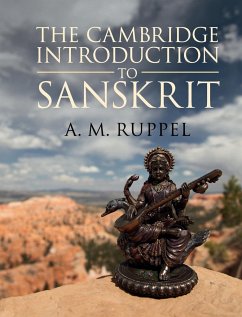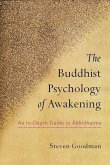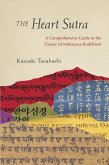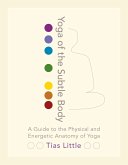A. M. Ruppel (New York Cornell University)
The Cambridge Introduction to Sanskrit
A. M. Ruppel (New York Cornell University)
The Cambridge Introduction to Sanskrit
- Gebundenes Buch
- Merkliste
- Auf die Merkliste
- Bewerten Bewerten
- Teilen
- Produkt teilen
- Produkterinnerung
- Produkterinnerung
This textbook uses modern approaches and tools to teach Sanskrit, introducing readers early on to annotated original passages. It requires no prior knowledge of linguistics or ancient languages, and clearly explains underlying structures and systems to facilitate memorisation. A dedicated website provides numerous resources for further practise.
Andere Kunden interessierten sich auch für
![The Buddhist Psychology of Awakening The Buddhist Psychology of Awakening]() Steven GoodmanThe Buddhist Psychology of Awakening33,99 €
Steven GoodmanThe Buddhist Psychology of Awakening33,99 €![When Love Comes to Light When Love Comes to Light]() Richard FreemanWhen Love Comes to Light24,99 €
Richard FreemanWhen Love Comes to Light24,99 €![The Heart Sutra The Heart Sutra]() Kazuaki TanahashiThe Heart Sutra29,99 €
Kazuaki TanahashiThe Heart Sutra29,99 €![The Art of Vinyasa The Art of Vinyasa]() Richard FreemanThe Art of Vinyasa18,99 €
Richard FreemanThe Art of Vinyasa18,99 €![Empires of the Silk Road Empires of the Silk Road]() Christopher I. BeckwithEmpires of the Silk Road28,99 €
Christopher I. BeckwithEmpires of the Silk Road28,99 €![Yoga of the Subtle Body Yoga of the Subtle Body]() Tias LittleYoga of the Subtle Body23,99 €
Tias LittleYoga of the Subtle Body23,99 €![The Clay Sanskrit Library: Ramayana The Clay Sanskrit Library: Ramayana]() Clay Sanskrit LibraryThe Clay Sanskrit Library: Ramayana100,99 €
Clay Sanskrit LibraryThe Clay Sanskrit Library: Ramayana100,99 €-
-
-
This textbook uses modern approaches and tools to teach Sanskrit, introducing readers early on to annotated original passages. It requires no prior knowledge of linguistics or ancient languages, and clearly explains underlying structures and systems to facilitate memorisation. A dedicated website provides numerous resources for further practise.
Produktdetails
- Produktdetails
- Verlag: Cambridge University Press
- Seitenzahl: 446
- Erscheinungstermin: 15. November 2017
- Englisch
- Abmessung: 260mm x 208mm x 28mm
- Gewicht: 1158g
- ISBN-13: 9781107088283
- ISBN-10: 1107088283
- Artikelnr.: 45153334
- Herstellerkennzeichnung
- Libri GmbH
- Europaallee 1
- 36244 Bad Hersfeld
- gpsr@libri.de
- Verlag: Cambridge University Press
- Seitenzahl: 446
- Erscheinungstermin: 15. November 2017
- Englisch
- Abmessung: 260mm x 208mm x 28mm
- Gewicht: 1158g
- ISBN-13: 9781107088283
- ISBN-10: 1107088283
- Artikelnr.: 45153334
- Herstellerkennzeichnung
- Libri GmbH
- Europaallee 1
- 36244 Bad Hersfeld
- gpsr@libri.de
A. M. Ruppel was the Townsend Senior Lecturer in the Greek, Latin and Sanskrit Languages at Cornell University, New York for nine years, and is currently Head of Sanskrit at St James Senior Boys' School in Ashford, UK. Ruppel has received the Stephen and Margery Russell Distinguished Teaching Award as well as a grant from the Cornell Center for Teaching Excellence, and is the author of Absolute Constructions in Early Indo-European (Cambridge, 2012).
Acknowledgements; Studying Sanskrit; List of abbreviations; Notes for the reader; 1. Writing Sanskrit; 2. The system of Sanskrit sounds; 2a. Word stress: heavy and light syllables; 3. Road maps: verbs; 4. The present tense; 5. Road map: nominals; 6. a-stems; 7. Vowel gradation and why we need to know about it; 8. Absolutives, ta-participle and infinitives; introduction to internal sandhi; 9.
-stems; 10. Prepositions and preverbs; 11. Introduction to external sandhi I: consonant sandhi; 12. Imperfect indicative and present potential; 13.
- and
-stems; sandhi II: visarga sandhi; 14. Compound nouns; 15. Consonant stems I; 16. Sandhi III: vowel sandhi; 17. Noun formation; 18. Athematic verbs I; 19. Athematic verbs II; 20. Introduction to pronouns; pronouns I; 21. The future tense; middle and passive voice; 22. More participles; pronouns II; 23. Relative and correlative clauses; 24. Consonant stems II; imperatives; 25. Noun stems gradation; consonant stems III; 26. i- and u-stems; 27. The perfect tense I: regular perfect formation; 28. The perfect tense II: irregular and unexpected forms; 29.
-stems, n-stems; the periphrastic future; 30. Secondary middle endings I: thematic verbs; 31. Secondary middle endings II: athematic verbs; 32. Pronouns III: 1st- and 2nd-person pronouns; 33. Desideratives and gerundives; 34. The periphrastic perfect; ta-participles ending in -na; 35. Perfect participles; more comparatives; 36. Absolute constructions; pronouns IV; 37. Numerals; 38. Aorists; 39. Pronouns V: asau/adas-; 40. Some irregular nouns; Appendices: Appendix 1. Devan
gar
practice handouts; Appendix 2. Background; Appendix 3. Reference; Index.
-stems; 10. Prepositions and preverbs; 11. Introduction to external sandhi I: consonant sandhi; 12. Imperfect indicative and present potential; 13.
- and
-stems; sandhi II: visarga sandhi; 14. Compound nouns; 15. Consonant stems I; 16. Sandhi III: vowel sandhi; 17. Noun formation; 18. Athematic verbs I; 19. Athematic verbs II; 20. Introduction to pronouns; pronouns I; 21. The future tense; middle and passive voice; 22. More participles; pronouns II; 23. Relative and correlative clauses; 24. Consonant stems II; imperatives; 25. Noun stems gradation; consonant stems III; 26. i- and u-stems; 27. The perfect tense I: regular perfect formation; 28. The perfect tense II: irregular and unexpected forms; 29.
-stems, n-stems; the periphrastic future; 30. Secondary middle endings I: thematic verbs; 31. Secondary middle endings II: athematic verbs; 32. Pronouns III: 1st- and 2nd-person pronouns; 33. Desideratives and gerundives; 34. The periphrastic perfect; ta-participles ending in -na; 35. Perfect participles; more comparatives; 36. Absolute constructions; pronouns IV; 37. Numerals; 38. Aorists; 39. Pronouns V: asau/adas-; 40. Some irregular nouns; Appendices: Appendix 1. Devan
gar
practice handouts; Appendix 2. Background; Appendix 3. Reference; Index.
Acknowledgements; Studying Sanskrit; List of abbreviations; Notes for the reader; 1. Writing Sanskrit; 2. The system of Sanskrit sounds; 2a. Word stress: heavy and light syllables; 3. Road maps: verbs; 4. The present tense; 5. Road map: nominals; 6. a-stems; 7. Vowel gradation and why we need to know about it; 8. Absolutives, ta-participle and infinitives; introduction to internal sandhi; 9.
-stems; 10. Prepositions and preverbs; 11. Introduction to external sandhi I: consonant sandhi; 12. Imperfect indicative and present potential; 13.
- and
-stems; sandhi II: visarga sandhi; 14. Compound nouns; 15. Consonant stems I; 16. Sandhi III: vowel sandhi; 17. Noun formation; 18. Athematic verbs I; 19. Athematic verbs II; 20. Introduction to pronouns; pronouns I; 21. The future tense; middle and passive voice; 22. More participles; pronouns II; 23. Relative and correlative clauses; 24. Consonant stems II; imperatives; 25. Noun stems gradation; consonant stems III; 26. i- and u-stems; 27. The perfect tense I: regular perfect formation; 28. The perfect tense II: irregular and unexpected forms; 29.
-stems, n-stems; the periphrastic future; 30. Secondary middle endings I: thematic verbs; 31. Secondary middle endings II: athematic verbs; 32. Pronouns III: 1st- and 2nd-person pronouns; 33. Desideratives and gerundives; 34. The periphrastic perfect; ta-participles ending in -na; 35. Perfect participles; more comparatives; 36. Absolute constructions; pronouns IV; 37. Numerals; 38. Aorists; 39. Pronouns V: asau/adas-; 40. Some irregular nouns; Appendices: Appendix 1. Devan
gar
practice handouts; Appendix 2. Background; Appendix 3. Reference; Index.
-stems; 10. Prepositions and preverbs; 11. Introduction to external sandhi I: consonant sandhi; 12. Imperfect indicative and present potential; 13.
- and
-stems; sandhi II: visarga sandhi; 14. Compound nouns; 15. Consonant stems I; 16. Sandhi III: vowel sandhi; 17. Noun formation; 18. Athematic verbs I; 19. Athematic verbs II; 20. Introduction to pronouns; pronouns I; 21. The future tense; middle and passive voice; 22. More participles; pronouns II; 23. Relative and correlative clauses; 24. Consonant stems II; imperatives; 25. Noun stems gradation; consonant stems III; 26. i- and u-stems; 27. The perfect tense I: regular perfect formation; 28. The perfect tense II: irregular and unexpected forms; 29.
-stems, n-stems; the periphrastic future; 30. Secondary middle endings I: thematic verbs; 31. Secondary middle endings II: athematic verbs; 32. Pronouns III: 1st- and 2nd-person pronouns; 33. Desideratives and gerundives; 34. The periphrastic perfect; ta-participles ending in -na; 35. Perfect participles; more comparatives; 36. Absolute constructions; pronouns IV; 37. Numerals; 38. Aorists; 39. Pronouns V: asau/adas-; 40. Some irregular nouns; Appendices: Appendix 1. Devan
gar
practice handouts; Appendix 2. Background; Appendix 3. Reference; Index.









